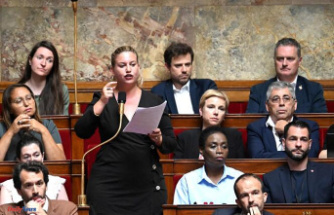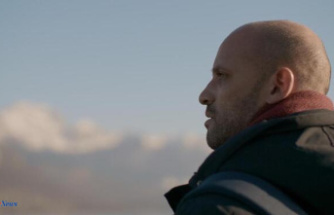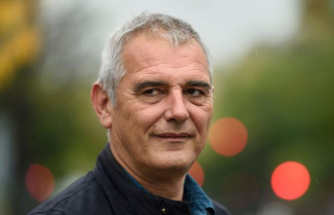Rising electricity and heating costs are putting pressure on museums, which are among the most energy-intensive cultural institutions. Art treasures love complicated climate technology, they don't like it too warm or too cold, not too humid or too dry. How can museums save now to avoid the shortage? Lights out - that seems to be the first and easiest way. Impressive churches, television towers, industrial monuments or museums stand in the dark, and light art no longer shines. John Jaspers, who has just opened the HYPERsculptures light exhibition, finds this "strange". Light art costs the museums little and lifts the spirits in gloomy times, says the 62-year-old director of the Center for International Light Art in Unna ntv.de.
ntv.de: Light art is disappearing throughout Germany. These are dark times for light art, aren't they?
John Jaspers: Museums have to think for themselves and also make cutbacks. Not only we as a light art museum have to become more sustainable, but everyone. Still, I think it's mostly symbolic. I understand that when it comes to light, i.e. electricity and energy, people look closely. I was interested in the question of how much energy our museum in Unna uses.
And? For many, light art sounds like a waste of energy.
I want to give an example from Stefan Simon, conservation researcher and specialist in the cultural sector: The depot of the Danish National Museum manages with eight kilowatt hours per square meter per year. That's about 50 times less than what an average museum in Germany needs. Why am I using this depot as an example? As a light art museum, we are about the same and need eight to nine kilowatt hours. In other words, light art doesn't consume that much electricity.
But why is the plug pulled so uncritically and quickly in light art?
I don't know why, but I find it very strange. It's a pity that the cultural sector is about to get its hands on it again. The need for art and culture is huge, as we saw after the lockdowns of the Corona crisis. Our museum is almost always fully booked.
What does light, or more precisely light art, do to us?
Light has to do with quality of life and is a safety factor. The public space must be illuminated. You can't switch everything off, that's also a question of security. Light lifts our spirits. It goes inward and is connected to our emotions. When people walk through a work by Keith Sonnier that sometimes glows red, sometimes blue, their feelings change depending on the light. This is a sensual experience. Light art works are spatial interventions, they change spaces and our perception. Light art speaks to everyone. At the same time, light means something different for everyone.
What does it mean to you?
Life. I like and need light. Here in the office you can see a plastic LED lamp that I bought in Berlin. A photo of a fluorescent tube hangs behind me, which in turn reflects the light on the ceiling. The worst thing for me would be to go blind.
For ten years you have been setting standards with light as museum director of the only light museum in the world. This also means that you have saved and switched to LED.
We did that continuously. Incidentally, not only as an energy measure, but also because LEDs last longer. Incandescent bulbs, like fluorescent tubes, were very inefficient. We use the latest technologies here in the museum. In the meantime, many of our installations are also equipped with motion detectors. The light only comes on when someone walks by.
Are you therefore more efficient and cheaper than many other museums?
Thanks to the LEDs, we are sustainable and at the same time energy-efficient. However, more is not possible at the moment. The city of Unna is currently investigating whether the roof of our building can be equipped with solar panels so that the building is self-sufficient. We are in a collective building, including the adult education center and a library.
The light art museum is located in the basement of the old Linden brewery, an industrial monument where the brewed beer was cooled. That doesn't exactly sound like a cheap new build.
(laughs) There are heaters everywhere in the building, just not in ours. And although you'd better leave your coat on in winter, we're well frequented. I don't know how expensive our energy bill will be, it's still being calculated. Electricity prices cannot go up indefinitely. Minister of State for Culture Claudia Roth gives one billion for a cultural energy fund. It's a nice gesture and promising, but we don't yet know how it will all be distributed. It's great that she's standing up and emphasizing that arts and culture are an integral part of life.
You said that the presentation of contemporary light art is one of the most economical there is. Can you justify that?
That was intentional, I wanted to hear a dissenting voice. As director of the light art museum, I have to defend light art again and again. I have an example to support the quote: After the exhibition "Macht! Licht!" at the Wolfsburg Art Museum came to an end this summer, the director there, Andreas Beitin, told me that his energy bill had never been so low.
Why is that?
It's very simple - if you show light art, you don't need air conditioning to keep the art at a certain temperature or humidity level. You don't need expensive spotlights that have to illuminate the pictures, objects and so on. The glow by itself is sufficient in light art.
Keyword sophisticated air conditioning technology: The German cultural council sees exhibits in German museums as endangered. Cultural treasures must be preserved for other generations. If buildings had to close due to the explosion in costs, there would be a lack of sufficient climate depots in this country. Is that black painting?
Not necessarily. Museums have to think about it and emergency plans are being worked on here in the Ruhr area. The question again: why are people cutting back on art and culture? What about, for example, huge factory parking lots that are empty at night and are still brightly lit during the day. What about shopping centers? Maybe we could put the lever somewhere else?
The "green museum" is much discussed. Museums should include concepts of sustainability. Is your museum already "green" with the measures mentioned?
no As already mentioned, we are 45 times cheaper than an average museum in Germany. But there's more we can do to be green. Our exhibition HYPERsculptures opened on Friday. The large sculpture by Giny Vos on our forecourt is powered by 57,600 LED lights. We now want to retrofit them with solar panels so that the work of art can take care of itself. Due to the energy crisis, however, we have decided to switch off our outdoor artworks at 10 p.m.
With HYPERsculptures you show extraordinarily large light works, the audience can almost bathe in the light. But it still doesn't work without switching off?
The museum needs energy, and it has to be saved. 550 artists from 57 countries took part in our International Light Art Award 2019. The question was also what they can achieve with light art without using more lamps. Reflections or mirrors were used. Light art is becoming more and more computer controlled. Art is always in motion and can become a driver for sustainable technologies.
Juliane Rohr spoke to John Jaspers
The HYPERsculptures exhibition runs from November 4th to April 30th, 2023 at the Center for International Light Art, Lindenplatz 1, 59423 Unna
(This article was first published on Sunday, November 06, 2022.)












